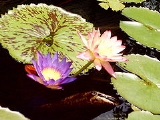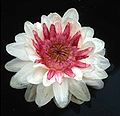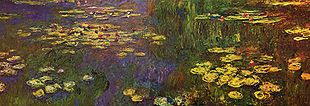
Nymphaeaceae
Encyclopedia

Flowering plant
The flowering plants , also known as Angiospermae or Magnoliophyta, are the most diverse group of land plants. Angiosperms are seed-producing plants like the gymnosperms and can be distinguished from the gymnosperms by a series of synapomorphies...
s. Members of this family are commonly called water lilies and live in freshwater areas in temperate and tropical climates
Tropics
The tropics is a region of the Earth surrounding the Equator. It is limited in latitude by the Tropic of Cancer in the northern hemisphere at approximately N and the Tropic of Capricorn in the southern hemisphere at S; these latitudes correspond to the axial tilt of the Earth...
around the world. The family contains eight genera. There are about 70 species of water lilies around the world. The genus Nymphaea contains about 35 species across the Northern Hemisphere
Northern Hemisphere
The Northern Hemisphere is the half of a planet that is north of its equator—the word hemisphere literally means “half sphere”. It is also that half of the celestial sphere north of the celestial equator...
. The genus Victoria contains two species of giant water lilies and can be found in South America. Water lilies are rooted in soil
Soil
Soil is a natural body consisting of layers of mineral constituents of variable thicknesses, which differ from the parent materials in their morphological, physical, chemical, and mineralogical characteristics...
in bodies of water, with leaves
Leaf
A leaf is an organ of a vascular plant, as defined in botanical terms, and in particular in plant morphology. Foliage is a mass noun that refers to leaves as a feature of plants....
and flower
Flower
A flower, sometimes known as a bloom or blossom, is the reproductive structure found in flowering plants . The biological function of a flower is to effect reproduction, usually by providing a mechanism for the union of sperm with eggs...
s floating on the water surface. The leaves are round, with a radial notch in Nymphaea
Nymphaea
Nymphaea is a genus of aquatic plants in the family Nymphaeaceae. There are about 50 species in the genus, which has a cosmopolitan distribution.-Name:The common name, shared with some other genera in the same family, is Water Lily....
and Nuphar
Nuphar
Nuphar is genus of aquatic plants in the family Nymphaeaceae, with a temperate to subarctic Northern Hemisphere distribution. Common names include water-lily , pond-lily, and spatterdock .A total of eight species and three hybrids are currently accepted in the genus...
, but fully circular in Victoria
Victoria (waterlily)
Victoria is a genus of water lilies, in the plant family Nymphaeaceae, with very large green leaves that float on the water's surface. Victoria amazonica has a leaf that is up to 3 m in diameter, on a stalk 7–8 m in length...
.
Water lilies are divided into two main categories: hardy and tropical. Hardy water lilies bloom only during the day, but tropical water lilies can bloom either during the day or at night, and are the only group to contain blue-flowered plants.
Classification
Nymphaeaceae has been investigated systematically for decades because they are believed to represent an early group of angiosperms. The basal angiospermsBasal angiosperms
The basal angiosperms are the first flowering plants to diverge from the ancestral angiosperm. In particular, the most basal angiosperms are the so-called ANITA grade which is made up of Amborella , Nymphaeales and Austrobaileyales...
are the first flowering plants to diverge from the ancestral angiosperm. In particular, the most basal angiosperms are so called the ANITA grade, which consist of Amborella
Amborella
Amborella is a genus of rare understory shrubs or small trees endemic to the island of New Caledonia. The genus consists of only a single species, Amborella trichopoda, and is the only member of the family Amborellaceae. Wood of Amborella lacks the vessels characteristic of most flowering plants...
, Austrobaileyales
Austrobaileyales
Austrobaileyales is the botanical name for an order of flowering plants, consisting of about 100 species of woody plants, perhaps the most famous of which is the spice star anise.- In different classifications :...
and Nymphaeales
Nymphaeales
Nymphaeales is an order of plants, which consists of water lilies and other aquatic plants.This order is considered to be a basal, or early diverging, group of angiosperms...
. The taxonomic position of the Nymphaeaceae has always been somewhat doubtful. The anatomy of these plants is more nearly that of the monocotyledons, while the venation of the leaves would indicate that they are dicotyledons. The sacred lotus
Nelumbo nucifera
Nelumbo nucifera, known by a number of names including Indian Lotus, Sacred Lotus, Bean of India, or simply Lotus, is a plant in the monogeneric family Nelumbonaceae...
family Nelumbonaceae was once thought to be a water lily, but is now recognized to be a highly modified eudicot in the order Proteales
Proteales
Proteales is the botanical name of an order of flowering plants. Such an order has been recognized by almost all taxonomists.-Families:The APG II system, of 2003, also recognizes this order, and places it in the clade eudicots with this circumscription:...
. The order Nymphaeales is a lineage separate from monocots or eudicots.
The current phylogenetic placement is:
Although Nymphaeaceae is small taxonomically, the relationships among genera of water lilies have not been clear and no single classification has become widely accepted. The family comprises two subfamilies: Cabomboideae, including Cabomba
Cabomba
Cabomba is an aquatic plant genus, one of two belonging to the family Cabombaceae. It has divided submerged leaves in the shape of a fan and is much favoured by aquarists as an ornamental and oxygenating plant for fishtanks...
and Brasenia
Brasenia
Brasenia is a genus belonging to the family Cabombaceae, consisting of one extant species widely distributed in warm temperate and tropical regions of the world. Brasenia is an aquatic perennial plant with floating, peltate leaves and rhizomatous stems...
, and Nymphaeoidae, with six remaining genera, Nymphaea
Nymphaea
Nymphaea is a genus of aquatic plants in the family Nymphaeaceae. There are about 50 species in the genus, which has a cosmopolitan distribution.-Name:The common name, shared with some other genera in the same family, is Water Lily....
,Nuphar
Nuphar
Nuphar is genus of aquatic plants in the family Nymphaeaceae, with a temperate to subarctic Northern Hemisphere distribution. Common names include water-lily , pond-lily, and spatterdock .A total of eight species and three hybrids are currently accepted in the genus...
, Barclaya
Barclaya
Barclaya is a genus of 3 - 4 species of flowering plants usually included in the family Nymphaeaceae but sometimes given their own family status as Barclayaceae on the basis of an extended perianth tube arising from the top of the ovary and by stamens that are joined basally. Barclaya are aquatic...
, Euryale
Euryale ferox
Euryale ferox is the only species in the genus Euryale. It is a flowering plant classified in the water lily family, Nymphaeaceae, although it is occasionally regarded as a distinct family Euryalaceae...
, Ondinea
Ondinea
Ondinea is a monotypic genus of flowering aquatic plants in the family Nymphaeaceae native to northwestern Australia. It grows from a corm-like rhizome and is found in ephemeral pools and rivers that are dry for a significant portion of the year...
and Victoria
Victoria (waterlily)
Victoria is a genus of water lilies, in the plant family Nymphaeaceae, with very large green leaves that float on the water's surface. Victoria amazonica has a leaf that is up to 3 m in diameter, on a stalk 7–8 m in length...
. Both are often recognized as families. In the past Nymphaeaceae often have been treated to include Cabombaceae
Cabombaceae
Cabombaceae is the botanical name of a family of flowering plants. The family has been recognised as distinct by at least some taxonomists and by APG III...
but this is often treated as a separate family in the same order (Nymphaeales
Nymphaeales
Nymphaeales is an order of plants, which consists of water lilies and other aquatic plants.This order is considered to be a basal, or early diverging, group of angiosperms...
). The genus Barclaya is sometimes given rank as its own family Barclayaceae on the basis of an extended perianth
Perianth
The term perianth has two similar but separate meanings in botany:* In flowering plants, the perianth are the outer, sterile whorls of a flower...
tube (combined sepals and petals) arising from the top of the ovary
Ovary
The ovary is an ovum-producing reproductive organ, often found in pairs as part of the vertebrate female reproductive system. Ovaries in anatomically female individuals are analogous to testes in anatomically male individuals, in that they are both gonads and endocrine glands.-Human anatomy:Ovaries...
and by stamens that are joined basally, but recent work lends weight to placing it in the Nymphaeaceae.
Description
The Nymphaeaceae are aquatic, rhizomatous herbs. The family is further characterized by scattered vascular bundles in the stems, and frequent presence of latexLatex
Latex is the stable dispersion of polymer microparticles in an aqueous medium. Latexes may be natural or synthetic.Latex as found in nature is a milky fluid found in 10% of all flowering plants . It is a complex emulsion consisting of proteins, alkaloids, starches, sugars, oils, tannins, resins,...
, usually with distinct, stellate-branched sclereids projecting into the air canals. Hairs are simple, usually producing mucilage
Mucilage
Mucilage is a thick, gluey substance produced by most plants and some microorganisms. It is a polar glycoprotein and an exopolysaccharide.It occurs in various parts of nearly all classes of plant, usually in relatively small percentages, and is frequently associated with other substances, such as...
(slime). Leaves are alternate and spiral, opposite or occasionally whorled, simple, peltate or nearly so, entire to toothed or dissected, short to long Petiole (botanyiolate), with blade submerged, floating or emergent, with palmate to pinnate venation. Stipules are either present or absent. Flowers are solitary, bisexual, radial, with a long pedicel and usually floating or raised above the surface of the water, with girdling vascular bundles in receptacle. Tepal
Tepal
Tepals are elements of the perianth, or outer part of a flower, which include the petals or sepals. The term tepal is more often applied specifically when all segments of the perianth are of similar shape and color, or undifferentiated, which is called perigone...
s are 4-12, distinct to connate
Connate
Connate may refer to* conjoined twins* connation, in botany...
, imbricate, and often petal-like. Petals lacks or 8 to numerous, inconspicuous to showy, often intergrading with stamens. Stamens are 3 to numerous, the innermost sometimes represented by staminodes. Filaments are distinct, free or adnate to petaloid staminodes, slender and well differentiated from anthers to laminar and poorly differentiated from anthers; pollen grains usually monosulcate or lacking apertures. Carpels are 3 to numerous, distinct or connate. Fruit is an aggregate of nuts, a berry, or an irregularly dehiscent fleshy capsule. Seeds are often arillate, more or less lacking endosperm
Endosperm
Endosperm is the tissue produced inside the seeds of most flowering plants around the time of fertilization. It surrounds the embryo and provides nutrition in the form of starch, though it can also contain oils and protein. This makes endosperm an important source of nutrition in human diet...
.
As invasive species
The beautiful nature of water lilies has led to their widespread use as ornamental plants. The Mexican water lilyNymphaea mexicana
Nymphaea mexicana is a species of aquatic plant that is native to the Southern United States and Mexico as far south as Michoacan. Common names include Yellow Waterlily, Mexican Waterlily and Banana Waterlily. It is perhaps best known as a noxious weed in wetlands outside of its native range, such...
, native to the gulf coast
Gulf of Mexico
The Gulf of Mexico is a partially landlocked ocean basin largely surrounded by the North American continent and the island of Cuba. It is bounded on the northeast, north and northwest by the Gulf Coast of the United States, on the southwest and south by Mexico, and on the southeast by Cuba. In...
of North America, is planted throughout the continent. It has escaped from cultivation and become invasive in some areas, such as California's
California
California is a state located on the West Coast of the United States. It is by far the most populous U.S. state, and the third-largest by land area...
San Joaquin Valley
San Joaquin Valley
The San Joaquin Valley is the area of the Central Valley of California that lies south of the Sacramento – San Joaquin River Delta in Stockton...
. It can infest slow moving bodies of water and is difficult to eradicate. Populations can be controlled by cutting top growth. Herbicides can also be used to control populations using glyphosate and fluridone.
Symbolism
The white water lilyWhite waterlily
White waterlily can mean:* Nymphaea alba, of Europe and North Africa* Nymphaea lotus, of East Africa and Southeast Asia* Nymphaea pubescens, of South Asia and Southeast Asia, and the national flower of Bangladesh...
is the national flower
National emblem
A national emblem symbolically represents a nation. Most national emblems originate in the natural world, such as animals or birds, but another object may serve. National emblems may appear on many things such as the national flag, coat of arms, or other patriotic materials...
of Bangladesh
Bangladesh
Bangladesh , officially the People's Republic of Bangladesh is a sovereign state located in South Asia. It is bordered by India on all sides except for a small border with Burma to the far southeast and by the Bay of Bengal to the south...
and State flower for Andhra Pradesh
Andhra Pradesh
Andhra Pradesh , is one of the 28 states of India, situated on the southeastern coast of India. It is India's fourth largest state by area and fifth largest by population. Its capital and largest city by population is Hyderabad.The total GDP of Andhra Pradesh is $100 billion and is ranked third...
, India
India
India , officially the Republic of India , is a country in South Asia. It is the seventh-largest country by geographical area, the second-most populous country with over 1.2 billion people, and the most populous democracy in the world...
. The Blue waterlily is the national flower
National emblem
A national emblem symbolically represents a nation. Most national emblems originate in the natural world, such as animals or birds, but another object may serve. National emblems may appear on many things such as the national flag, coat of arms, or other patriotic materials...
of Sri Lanka
Sri Lanka
Sri Lanka, officially the Democratic Socialist Republic of Sri Lanka is a country off the southern coast of the Indian subcontinent. Known until 1972 as Ceylon , Sri Lanka is an island surrounded by the Indian Ocean, the Gulf of Mannar and the Palk Strait, and lies in the vicinity of India and the...
. It is also the birth flower for July.
In visual arts

Claude Monet
Claude Monet was a founder of French impressionist painting, and the most consistent and prolific practitioner of the movement's philosophy of expressing one's perceptions before nature, especially as applied to plein-air landscape painting. . Retrieved 6 January 2007...
(1840–1926) in a series of paintings
Water Lilies
Water Lilies is a series of approximately 250 oil paintings by French Impressionist Claude Monet . The paintings depict Monet's flower garden at Giverny and were the main focus of Monet's artistic production during the last thirty years of his life...
.
See also
- NelumboNelumboNelumbo is a genus of aquatic plants with large, showy flowers resembling water lilies, commonly known as lotus. The generic name is derived from the Sinhalese word Nelum. There are only two known living species in the genus. The sacred lotus is native to Asia, and is the better known of the two...
- PondPondA pond is a body of standing water, either natural or man-made, that is usually smaller than a lake. A wide variety of man-made bodies of water are classified as ponds, including water gardens, water features and koi ponds; all designed for aesthetic ornamentation as landscape or architectural...
- Pamplemousses Botanical GardenSir Seewoosagur Ramgoolam Botanical GardenThe Sir Seewoosagur Ramgoolam Botanical Garden , commonly known as the Pamplemousses Botanical Garden, is a popular tourist attraction near Port Louis, Mauritius, and the oldest botanical garden in the Southern Hemisphere...
, famous for its giant water lilies

